Considering the Tuscany-Lombardy epoch and its tradition of portraying the Last Supper I put something together: maestro Leonardo was really innovative, but it seems he was also really good at presenting the fruits of his era. As in general, nowadays, people know only him and tend to attribute many advances directly to him, meanwhile he was also standing on shoulders of the greats of his era. Within his work, there was no secrecy – just the Venetian drawing was serving directly to Leonardo for gathering his knowledge, from my point of view, to put together his ideas or their alternatives, and it was not meant for a public presentation.
During all the history the pairs of the first called brothers Peter and Andrew, John and James the Greater were prominent, and always very central ones with Jesus in the very most middle.
Florentine monumental LS frescoes period had an important point with Taddeo Gaddi’s Last Supper and Tree of Life in Santa Croce church (1335), where was Judas put distinctively at the opposite side of table and it was the first monastic refectory with LS in the city [1].
Regarding the apostles’ illustration during this era and at the region: Especially valuable are name labeled LSs. I put a considered list as: Andrea del Castagno’s (see the head-line image), Pietro Perugino’s, Ponte Capriasca’s (one situated there) and the Study for Leonardo’s Last Supper. And also Domenico Ghirlandaio’s, as he painted three still preserved LSs.
After we can see a quite known standard: Peter on the left and John on the right of Jesus from a spectator point of view. Master Leonardo’s LS is putting Peter at side of John as in Santa Croce’s (be it an another option), but on his Study, he is holding or annotating this tradition.) In other words St. Peter occupies the most prominent place at Jesus’s right.
The brother pairs longed for somehow similar appearance, with James the Greater always older than the youngest John, but still not more than a mid-age man as he was martyred as the first apostle.
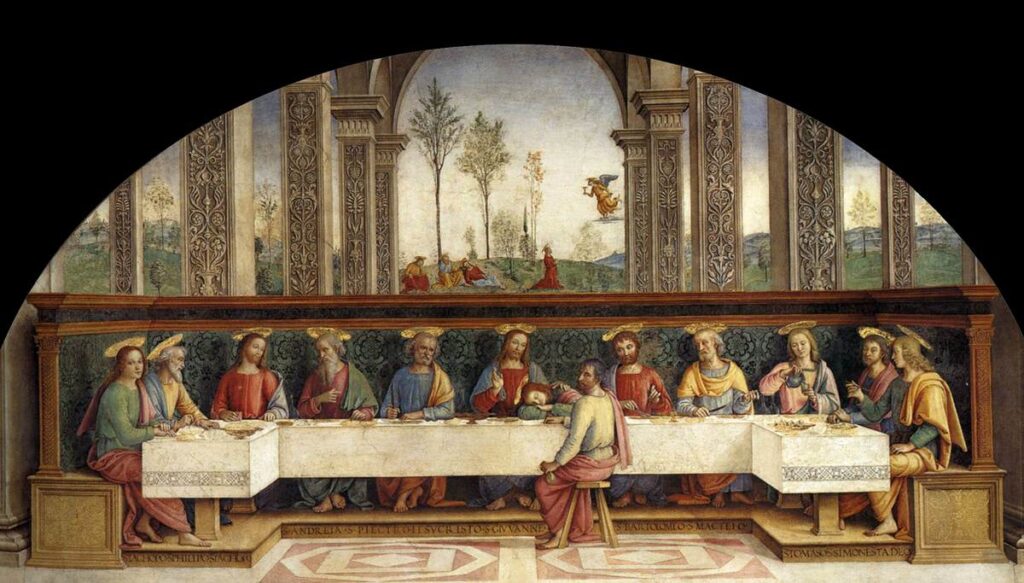
Lettered seating order in Perugino’s LS, left to right: S. Iachopo, S. Philipo, S. Iachopo (probably the Greater, brother of St. John, also his vestige repeats in the small Gethsemany garden’s scene – where his head rests on a tree stump possibly anticipating his early martyrdom by beheading), S. Andreia, S. Piectro, S. Givanne, S Bartolomeo, S. Macteo, S. Simone, S. Tadeo [2]
In a comparison seating order as depicted in Castagno’s LS, left to right: (left out – probably James the Minor), S. Philippus, S. Tiomas, S. Iacobus (probably the Greater, a brother of St. John), S. Petrus, S. Iohanne, (S.) Andreas, S. Barthoiomeus, S. Tiadeus, S. Simon, (probably St. Matthew) [3]
Inspirations for a seating order
1) Apostle listings from synoptic gospels (and Acts of the apostles), which are putting together:
a) Peter, Andrew, John, James the Greater, +Philip (he is always put on 5th position on this list)
b) Tomas, Matthew, Bartholomew
c) Simon the Zealot, Jude Thaddeus
This was fully used on Perugino’s (1493-1496, Florence), which was contemporary with Leonardo da Vinci’s, and possibly on Ghirlandaio’s LS (Ognissanti, Florence, 1480; San Marco, Florence, 1486).
2) Common feast day, Simone and Jude-Thaddeus were put together also because of the tradition and their feast day has been the same for the Roman Catholic church. They seem to be depicted together on all of these paintings.
Philip and James the Minor is another apostle pair with joined feast day from earliest centuries. They are put together in Castagno’s, almost certainly in Perugino’s, and possibly in all Ghirlandaio’s.
Less common ideas for a grouping were:
3) There are three apostle saints venerated in Florence: St. James the Greater, St. Thomas, St. Philip and this was used once on Castagno’s as he was painting for a nun Florence monastery. Maybe to remember them their fathers and families which were parts of different guilds with these patron saints. [4]
Then was this motive again used (maybe randomly) with somebody annotating Ponte Capriasca’s 100 years later (Lugano, Switzerland – close to Milano, Italy).
4) there is a group dealing with Bethsaida village: Bartholomew, Andrew, Philip, Peter and the idea seems to be sketched on the Venetian Drawing. And possibly on master Leonardo’s LS.
The other standards for individual apostles, which I have found in our mentioned name labeled LSs and can serve as an auxiliary guide for interpretation of LSs. especially in the region of Tuscany-Lombardy during and preceding Leonardo’s epoch:
Philip’s hand(s) on our list are depicted as acting, never resting.
Thomas is always up to a mid-age and self-absorbed pensative, with Leonardo giving him a more active role.
Simon the Zealot is elderly, with a rather pious, deeply inner living reaction, always next to Thaddeus.
Jude Thaddeus has hands always in a defence or pointing to Judas, apart of Ponte Capriasca: this seems to come from all the history, when they were interchanged. His hand can be also on his heart, or pointing to his heart. Refering to Taddai meaning – T(h)adda(i) can mean a heart in Hebrew/Aramaic. [5, 6]
Matthew can be majestic as a future evangelist or a more “earthy” as on Leonardo’s as he was a tax collector.
And than there is James the Minor, always younger than James the Greater, and at the end of table, sometimes more of his figure disclosed there and he has his importance as the first future Jerusalem’s bishop (it was held up to very modern times by Catholics). L’s LS is the exception here, but as I propose with being the highest figure this compensates enough, leaving St. Philip to his calling/asking gesture. In Leonardo’s LS this creates two of the most important triplets Peter – John – James the Greater and Peter – John – James the Minor as they are characterized in the Bible.
And in every painting it is John portrayed as the youngest, never James the Minor or Philip.
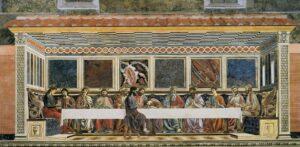
Literature and comments
[1] Leonardo’s Incessant Last Supper; p. 63-65; Leo Steinberg; 2001
[2] Perugino’s list of names in English: James (probably the Minor), Philip, James (probably the Greater), Andrew, Peter, John, Bartholomew, Matthew, Simon the Zealot, Jude Thaddeus
[3] Castagno’s list of names in English: (left out – probably James the Minor), Philip, Thomas, James (probably the Greater, a brother of St. John), Peter, John, Andrew, Bartholomew, Jude Thadeus, Simon the Zealot, (probably St. Matthew)
[4] Leonardo’s Incessant Last Supper; p. 80 n. 12; Leo Steinberg; 2001
[5] https://en.wikipedia.org/wiki/Thaddeus
[6] This raises a question whether a dislocated heart-shaped blot on Jude Thadeus in the Study is a random relic or Leonardo created it intentionally probably by a black chalk to commemorate a heart.
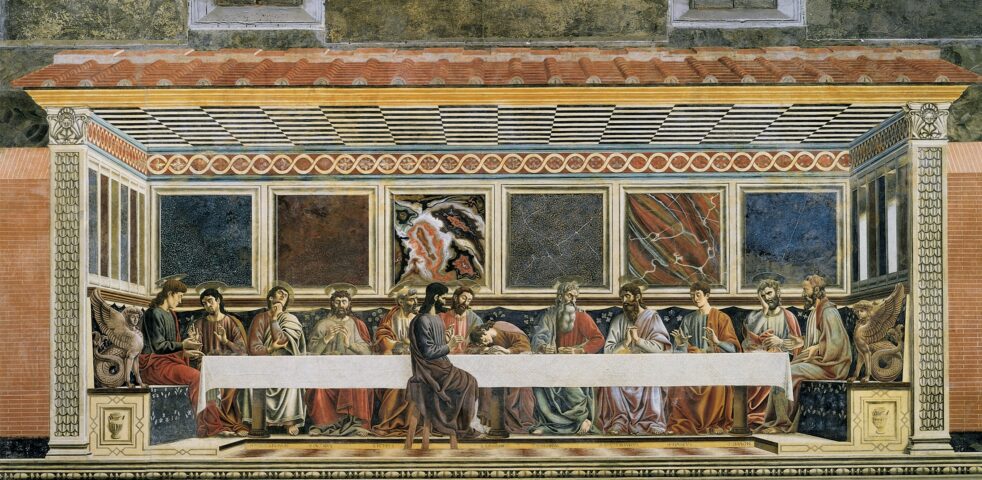
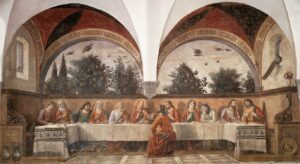
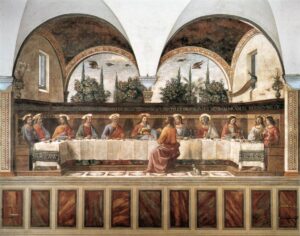
Sed risus felis, cursus eu varius quis, fermentum a leo. Morbi quis odio sed purus semper maximus. Geralda Ancell Neron